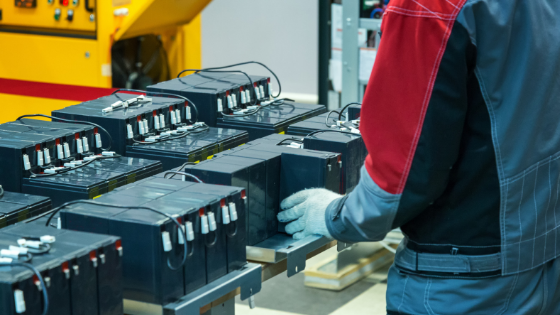The battery manufacturing industry is vital to so many other industries, from tech to automotive manufacturing. And like other manufacturing sectors, employees are faced with a high level of workplace risk.
That’s why it’s your responsibility to know the risks your employees face and take steps to keep them safe. Here’s the biggest hazard facing your employees and regulations you need to follow to protect them from harm.
The Risk of Inorganic Lead Dust
The battery manufacturing industry’s single biggest hazard is inorganic lead dust.
Lead is a non-biodegradable, toxic heavy metal with no physiological benefit to humans. Battery manufacturing workers, construction workers, and metal miners are at the highest risk of exposure.
Typically, people are exposed to lead either through inhalation or ingestion. In the case of inorganic lead dust, inhalation is most common.
Once lead enters the body, it circulates through the bloodstream and settles in your internal organs. Eventually, lead accumulates in your bones. Once it settles there, the half-life of bone-deposited lead is 20 to 30 years, and turnover of bone tissue releases lead back into the bloodstream.
The effects of lead dust exposure are the same regardless of whether the lead is inhaled or swallowed. The main target is the nervous system, either directly or indirectly. Lead interferes with the development of the nervous system and disrupts neurotransmitter release.
It also indirectly harms the nervous system by interfering with other bodily systems that support it, resulting in everything from hypertension to impaired thyroid function to insomnia to fine muscle tremors to pre-term birth.
Safety Standards
Because the risks associated with lead exposure are so high, battery manufacturers have an especially high responsibility to their workers.
In order to be effective, your safety and health procedures must be comprehensive. You have to address all aspects of the problem. It’s not enough just to have a health and safety policy – you need training, personal protective equipment (PPE), and regular safety meetings, to name a few.
If you’re not sure where to start, we’re addressing two main OSHA regulatory areas: personal protective equipment and the safe management of hazardous materials.
Personal Protective Equipment
As an employer, it is your responsibility to ensure that your workers have access to the appropriate personal protective equipment. This includes things like:
- Head protection
- Eye and face protection
- Hand protection
- Foot protection
- Electrical protection
- Respiratory protection
In industries like battery manufacturing, respiratory protection is especially important. It is your responsibility to provide protective equipment and respirators which can handle the hazards your workers deal with. You’re also responsible for checking and maintaining equipment to ensure it’s in good working order.
If your workers bring in their own protective gear, you are responsible for checking it to ensure that it meets the appropriate safety standards. If it doesn’t, you have to provide alternative equipment.
Hazardous Substances
Lead dust is a big part of battery manufacturing. That’s why employers have to know their regulatory responsibilities.
Employers must ensure that employees are not exposed to lead concentrations greater than 50 micrograms per cubic meter of air, averaged over an eight-hour period.
Barring certain exceptions, employers are responsible for collecting full-shift personal samples to monitor an employee’s daily exposure to lead.
Making Battery Manufacturing Safer
Battery manufacturing is a high-risk, hazardous industry, but that doesn’t mean that workers can’t get home safe to their families at the end of the day.
If you’re ready to commit to keeping your employees safe, you need the right tools for the task. That’s where we can help. We offer EHS software solutions to help you better manage your operations. Ready to find out how we can help? Use our contact page to get in touch today.
